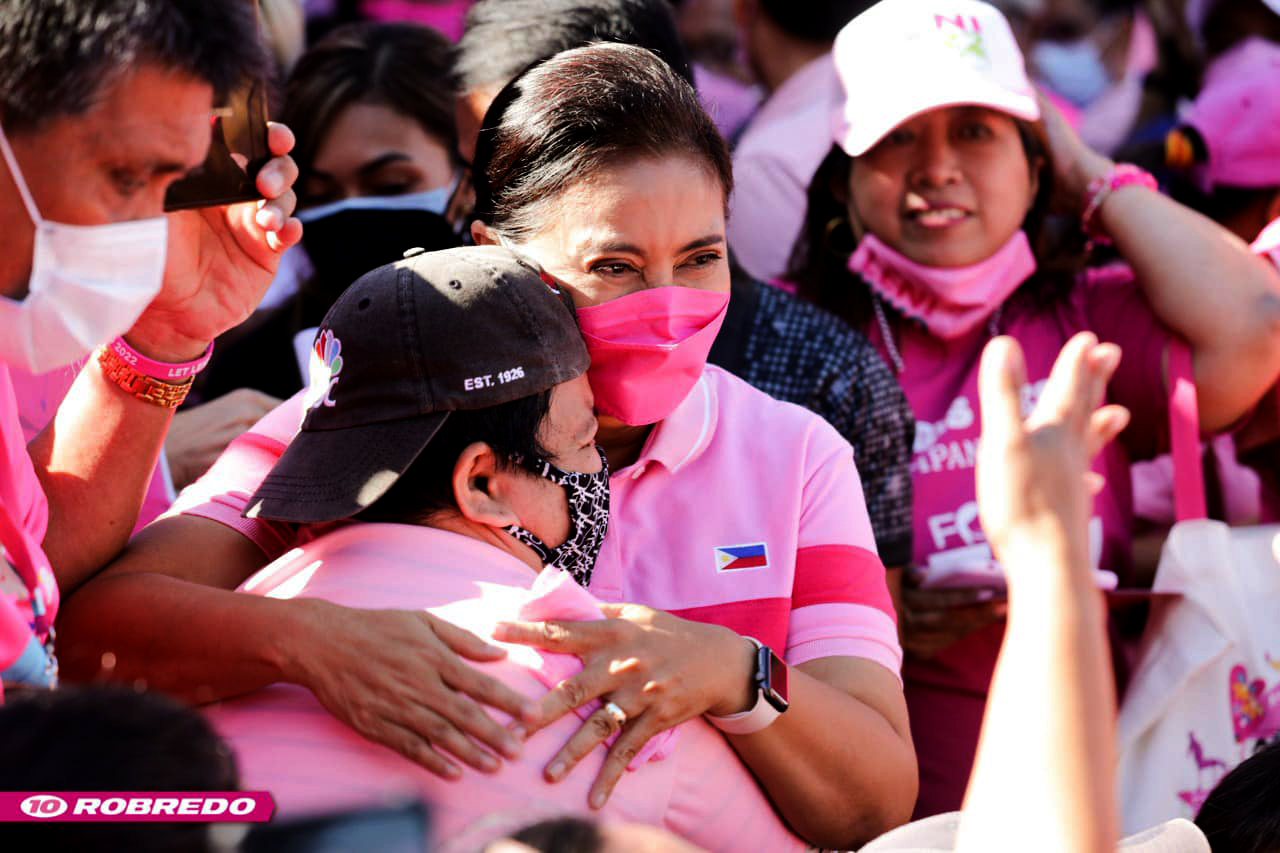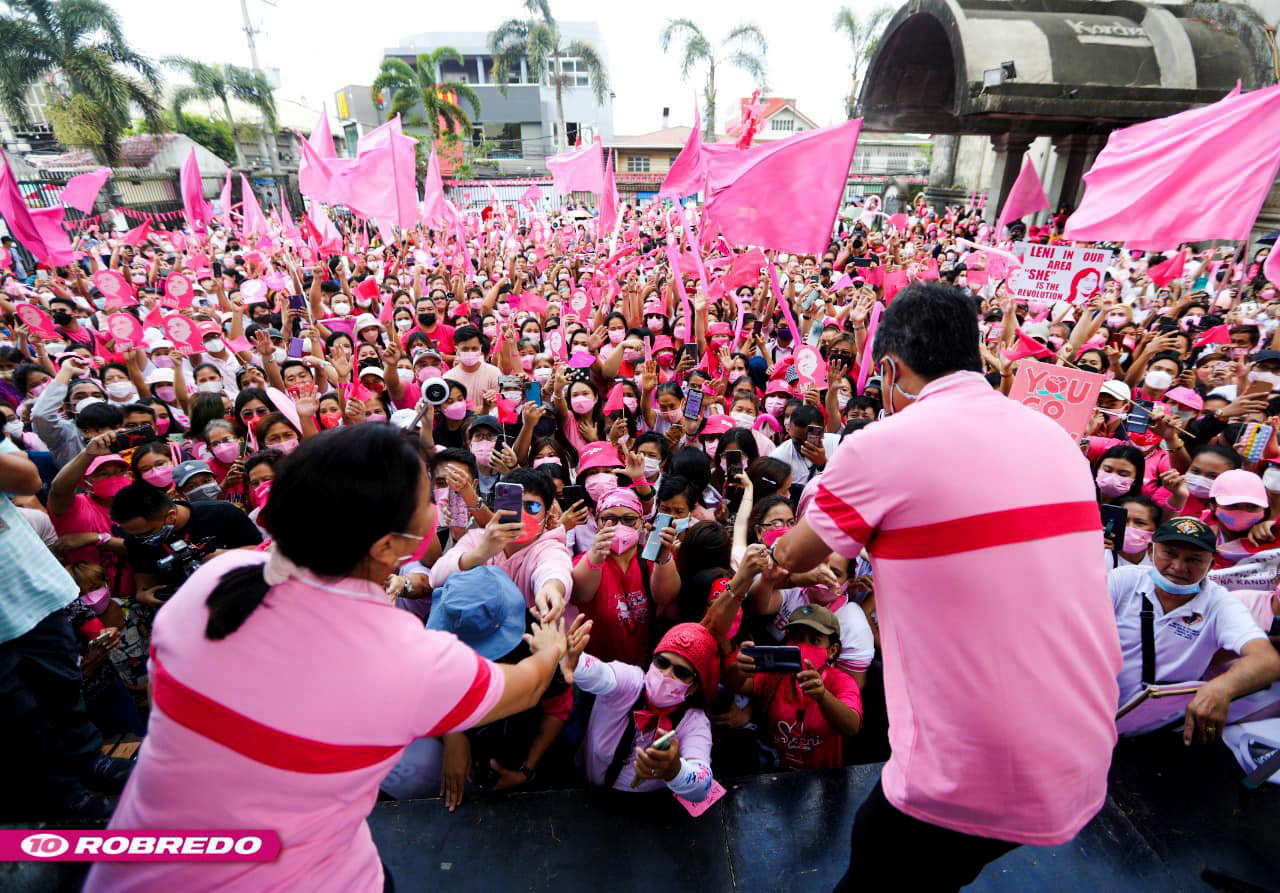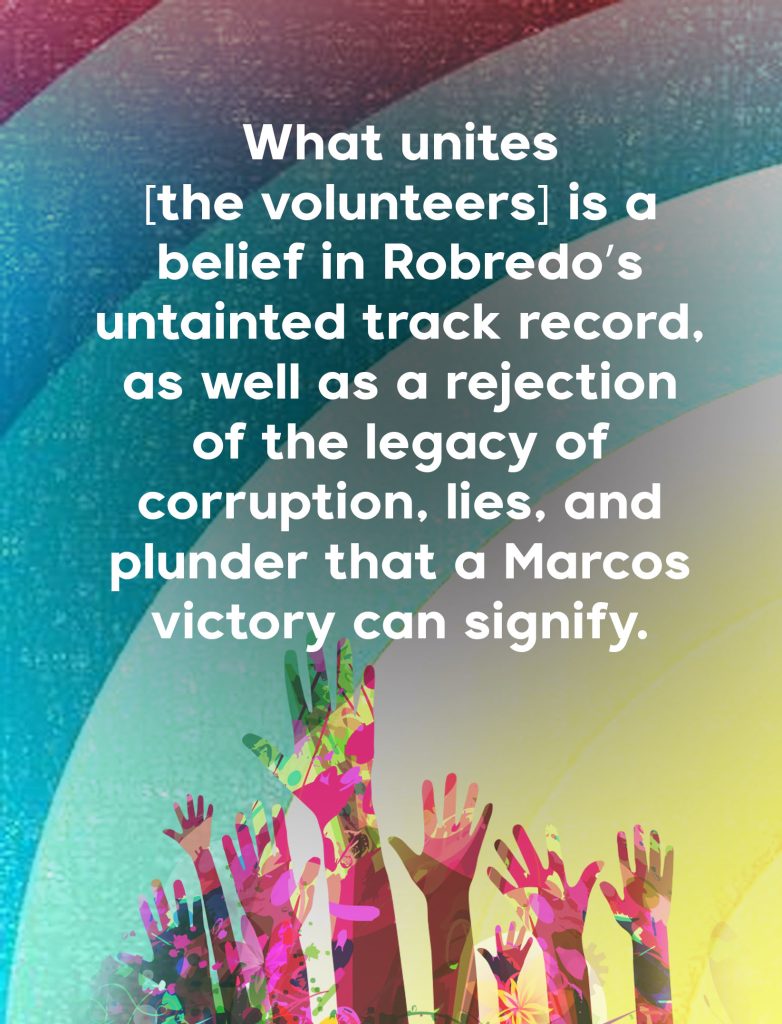From the beginning of her bid to succeed controversial strongman Rodrigo Duterte as president, Philippine Vice President and opposition leader Leni Robredo has acknowledged the groundswell of support she had received while making the tough decision to run. But she has repeatedly asked supporters to dig even deeper for what promises to be an uphill fight.
“I know that many have you been working on your own for months now to achieve this goal,” Robredo told supporters when she announced her candidacy in October. “I have complete trust in you. And so, I call on you. Stand up. I’m sure others will stand up beside you.”
Months later, Robredo still trails behind frontrunner Ferdinand “Bongbong” Marcos Jr., son and namesake of the late dictator Ferdinand Marcos, whose brutal regime had been likened to Duterte’s. Robredo and Marcos faced off for the vice presidency in the 2016 polls, and Robredo’s narrow victory was a stumble in the Marcoses’ years-long attempt to regain power and rehabilitate their name.
This time, Robredo is the underdog in what has all the makings of a David vs. Goliath showdown. The Marcos camp enjoys a well-oiled machinery with a solid network of local politicians and seemingly bottomless funding. A massive and unchecked disinformation campaign, pundits say, has fueled the former senator’s popularity, abetted by Duterte’s routine undermining of press freedom and mainstream media.

Philippine Vice President and presidential aspirant Leni Robredo hugs one of her supporters in one of her campaign sorties in the lead-up to the May 9, 2022 elections. Her past civic work as a lawyer for grassroots communities and efficient handling of the affairs of her office and its pro-poor programs, including during the pandemic, has earned her widespread praise. (Photo from the Leni Gerona Robredo Facebook page.*)
While the Philippines is a multi-party democracy on paper, a deeply entrenched system of patronage and clientelism has historically eroded the strength and coherence of parties. Elections are often reduced to popularity contests instead of a clash of platforms and ideologies. As a result, campaigns — and the funding necessary — are dispensed with an eye out for popular candidates who stand a good chance of winning, with local leaders vowing to deliver votes in return.
But what the Robredo campaign may lack in resources, it makes up for in other things. After the start of the official campaign period in February 2022, social media lit up with volunteer-led initiatives to drum up support for the economist and lawyer. Since then, mammoth crowds have greeted her in sorties in places like Cebu and Iloilo in central Philippines, Quezon City in Metro Manila, and, most recently, just outside the capital in Cavite province, where organizers said 47,000 showed up in rejection of the governor’s earlier promise of a solid Marcos vote.
This palpable and contagious spirit of grassroots volunteerism, of a highly engaged and dependable core of supporters, has energized her candidacy — something her camp says is hard to duplicate even with money and machinery. With just two months to go before election day on May 9, 2022, it can potentially turn the tide in this year’s all-important polls.
Running a ‘People’s Campaign’
A short clip captures the drive, enthusiasm, and sense of urgency powering what the Robredo camp has described as a “people’s campaign.” Originally uploaded on TikTok, the video has been viewed some 22,000 times in less than a week on Facebook.
In the video, some youths paint a wall pink, Robredo’s campaign color. One stands on a stepladder, tracing a word’s outline, while two others sketch. A young-sounding female voiceover says, “Yesterday, someone said we were just wasting our time doing the mural.”
The voice goes on to recall how the group has spent five days painting the mural, the past months’ other murals, then the other activities organized by other youth volunteers — all while the scene cuts to amateur footage of young people painting once-blank walls, preparing hot meals, doing relief work and, every now and then, goofing off.
While volunteering, the voice says, talks with people and witnessing so many others sacrificing their time, energy, and money for what Robredo’s campaign meant have been more than enough proof that she had not been wasting her time. And then the mural is completed, with a Robredo slogan smack in its center: “Mas radikal ang magmahal (To love is more radical).”
Yet before the murals, as well as relief operations in the wake of Typhoon Rai (Odette), volunteers had already spearheaded activities from caravans that drew big crowds in many towns and cities to regular “pa-lugaw” or soup (actually rice porridge) kitchens.
Following Robredo’s announcement of her bid, the campaign has banked on the “huge outpouring of support from different sectors and different areas of the country,” her spokesperson Barry Gutierrez said in December 2021, with thousands of volunteers making rounds in their communities, talking to neighbors and coworkers, family and friends.
This has allowed Robredo to “at least keep pace” with the other candidates, many of whom had a lot more time to prepare and lay the groundwork necessary for a grueling and costly presidential run, Gutierrez said. He added, “Despite the fact that it’s clear that we have a lot of numbers to make up in the next few months, we are confident that with the support of these very energetic, very motivated volunteers all over the Philippines, we would be able to do it.”
First-time campaigners
Indeed, social media is teeming with testimonies from individuals who are actively campaigning for a candidate for the first time in their lives. From university students to young professionals, LGBT and farmers’ groups to a tricycle driver whose video of a heartfelt plea for honest governance had gone viral on social media, Robredo supporters seem to defy easy description as a group. What unites them is a belief in Robredo’s untainted track record, as well as a rejection of the legacy of corruption, lies, and plunder that a Marcos victory can signify.
Like the muralists, many “kakampinks”— a fusion of the Tagalog word for “ally,” kakampi, and “pink” — spend their own money and take time away from work or school to print, mount, or distribute campaign materials. They go around talking to people about Robredo’s vision, a real flesh-and-blood pushback against the slew of coordinated propaganda on social media.
On the ground, they have initiated one volunteer-driven activity after another, from public utility drivers adorning their vehicles with Robredo posters and fisherfolk holding fluvial parades to doctors conducting medical missions, lawyers giving free consultations, and small business owners publicly throwing their support behind the vice president.
Private individuals talk about turning down lucrative offers to take part in the Marcos campaign, from refusing to rent out venues to saying no to performing at a sortie. It is not uncommon to read about people who don’t belong to groups venturing out on their own, armed with nothing more than campaign materials and Robredo’s urgent message of change and inclusion.
Online, folders of campaign materials are widely shared so people can print tarpaulins, stickers, and calendars on their own, while social media groups connect supporters with an extra poster or two to anyone nearby who could use them. Animators, graphic designers, and other artists have also come together to produce campaign collaterals from t-shirts to videos.
The activities’ geographic spread goes beyond Robredo’s bailiwick of Bicol in central Philippines or Metro Manila with its energetic middle class. There are medical missions as far north as Isabela province and caravans in Cagayan de Oro City in Duterte’s home region of Mindanao. Volunteer groups have been organized in Hong Kong, Japan, Italy, the United States, and elsewhere.
Robredo’s volunteer-driven sorties and rallies, the most well-attended in recent memory, are a powerful testament to such tireless organizing and volunteer work.
Converting Marcos supporters
Her supporters had even gone to potentially hostile territory, holding motorcades in Duterte stronghold Davao City and putting up Robredo posters around Ilocos Norte, which the Marcos clan has ruled for generations.
“It’s hard to convince die-hard loyalists or apologists or fanatics to vote for Leni,” said Zsa Zsa Raval, coordinator of the Ilocos Norte for Leni-Kiko group in a report. “So, our goal is to convince and enlighten the undecided voters, especially the young new voters.”
The main challenge for Robredo’s camp is how to chip away at the huge lead established by Marcos Jr., whose popularity has been attributed to a years-long disinformation campaign built on misleading claims about him and his father’s dictatorial rule, which was marked by widespread human rights abuses and plunder of the nation’s coffers.
For “kakampinks,” this means engaging Marcos’s core supporters, who can also be passionate and driven, at times to the point of fanaticism. While possibly nudged by fake news and revisionist history, they yearn for otherwise reasonable things, like inclusive growth, quality jobs, cheaper electricity, better internet connection, and improved infrastructure.
Every politician is corrupt anyway, goes a common refrain; at least the Marcoses built many things, like hospitals and bridges. In campaign sorties, artifacts from the dictatorship such as the Bagong Lipunan (New Society) song, help fuel the nostalgia. That the dictatorship ushered in a dark time in Philippine history thus appears to be less of an election issue for the most ardent of Marcos’s supporters, many of whom are disillusioned by how the People Power Revolution more than three decades ago restored democracy but failed to lead to more systemic changes or improve the lives of many Filipinos.

Enthusiastic crowds usually greet Robredo, along with her running mate Senator Francis Pangilinan and their senatorial slate, in every rally such as this one in the province of Cavite, 30 kms south of Manila. With no sophisticated campaign machinery and no deep pockets, the Robredo campaign is aided largely by the efforts of voters seeking change. (Photo from the Leni Gerona RobredoFacebook page.*)
Volunteerism and governance
For its part, that Robredo’s campaign is volunteer-led is arguably its strongest message, especially in what it signals about the kind of government that she has the potential to build and lead.
As her campaign continues to gain momentum, it has begun to earn comparisons with similar people-led movements in the country’s history, including the historic candidacy of former president Corazon Aquino that ultimately led to Marcos’s ouster in February 1986.
Supporters of the reluctant Aquino, widow of slain opposition leader Benigno Aquino Jr., had gathered one million signatures to convince her to run against the ailing dictator, who had earlier called for snap elections amid mounting pressure and deteriorating social conditions.
When Marcos was declared the winner amid reports of violence and electoral fraud, that grassroots effort transformed into a civil disobedience campaign and a boycott of companies linked to Marcos and his cronies, culminating in the People Power Revolution that toppled the dictatorship and marked democracy’s comeback in the country after two decades of authoritarian rule.
Ironically, the vigor behind the Robredo campaign is somewhat also reminiscent of the wave of popular support that handed Duterte the presidency in 2016. Characterized as “people-initiated” as well, the so-called Duterte phenomenon manifested in throngs of supporters who were solid, passionate, and unfazed by his controversial remarks. Many also spent their own money to reproduce campaign materials and helped spread his anti-elite message anchored on inclusion and change that resonated with many Filipinos.
Six years later, with perhaps the most important election since 1986 on the horizon, Robredo’s bid seeks to make history anew. Considering what’s at stake, its brand of dynamic, decentralized, and people-centric campaign stands in sharp contrast to the authoritarian tendencies that have made Duterte’s presidency one of the bloodiest, most brutal on record.
Clearly, a “people’s campaign” may win elections. But for it to stay on course and carry out its promise requires a continuing commitment to the people on the ground who had made it possible in the first place. And whether or not Robredo’s campaign will work in charting a new course for a deeply divided nation remains to be seen. ●
* The editors exerted efforts to obtain permission for the use of these photos. They were advised by three separate Leni Robredo campaign volunteer groups to attribute said photos to the Facebook page from which they were downloaded.
Glenn Diaz is a writer, graduate student, and teacher. His second novel Yñiga is forthcoming from Ateneo de Manila University Press.




















